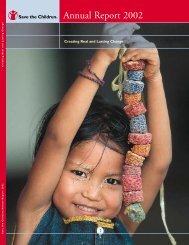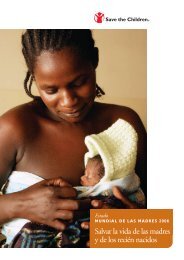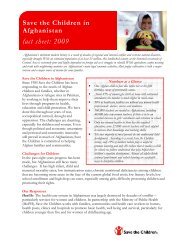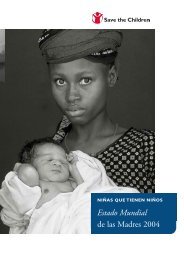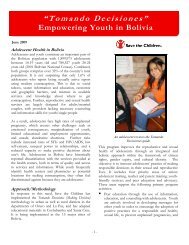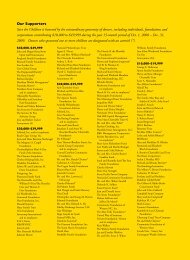Adolescent Sexual and Reproductive Health Toolkit for - UNFPA
Adolescent Sexual and Reproductive Health Toolkit for - UNFPA
Adolescent Sexual and Reproductive Health Toolkit for - UNFPA
Create successful ePaper yourself
Turn your PDF publications into a flip-book with our unique Google optimized e-Paper software.
There are several models <strong>for</strong> adolescent participation<br />
that have been used in development contexts <strong>and</strong><br />
that could be adapted <strong>for</strong> use in emergency situations.<br />
Two examples of field-tested models are<br />
described below.<br />
The Partnership-Defined Quality <strong>for</strong> Youth (PDQ-Y)<br />
methodology, which is used by Save the Children,<br />
engages youth <strong>and</strong> health workers in a process that<br />
identifies adolescent SRH needs, defines quality,<br />
explores ways of collaborating, <strong>and</strong> emphasizes<br />
mutual responsibility <strong>for</strong> problem solving. The<br />
process involves meeting with adolescents <strong>and</strong><br />
health workers separately to explore their perceptions<br />
of ASRH needs, quality of care, the strengths <strong>and</strong><br />
weaknesses of the existing services, <strong>and</strong> the responsibilities<br />
<strong>and</strong> rights of the clients <strong>and</strong> health workers.<br />
Then, there is a bridging the gap session, during<br />
which adolescents <strong>and</strong> health workers come together<br />
to share their ideas <strong>and</strong> come up with ways to<br />
collaborate with the shared vision of improving<br />
adolescent-friendly services. In the final step, adolescents<br />
<strong>and</strong> health workers work in partnership to<br />
develop <strong>and</strong> implement action plans, <strong>and</strong> adolescents<br />
are involved in monitoring the quality improvements<br />
of health services (Save the Children, 2008).<br />
The Youth-Adult Partnerships (YAP) model,<br />
developed by Family <strong>Health</strong> International <strong>and</strong><br />
YouthNet, is based on the principles that youths<br />
have the right to participate; that participation makes<br />
programs more relevant <strong>and</strong> sustainable; <strong>and</strong> that<br />
participation increases the resiliency <strong>and</strong> development<br />
of young persons. Through this model, adults <strong>and</strong><br />
adolescents engage not only in dialogue, but also in<br />
action as equal partners. The YAP model integrates<br />
adolescent perspectives <strong>and</strong> skills with adult experience<br />
<strong>and</strong> wisdom; offers each party the opportunity<br />
to make suggestions <strong>and</strong> decisions; recognizes <strong>and</strong><br />
values the contributions of each; <strong>and</strong> allows youth<br />
<strong>and</strong> adults to work in full partnership envisioning,<br />
developing, implementing, <strong>and</strong> evaluating programs<br />
(FHI, 2005). In order <strong>for</strong> YAP to be successful, adolescents<br />
<strong>and</strong> adults must show mutual respect. Adults<br />
must feel confident in the adolescents’ abilities to<br />
make decisions; they must see the adolescents’ assets<br />
<strong>and</strong> recognize the value of what they can contribute to<br />
the partnership; <strong>and</strong> they must be willing to provide<br />
the adolescents with additional training, if needed.<br />
(Norman, J. Advocates <strong>for</strong> Youth, 2001).<br />
The participation of high-risk adolescents,<br />
including those who are very young, separated<br />
from their families, heads of household,<br />
CAAFAG, marginalized or have disabilities, is<br />
particularly important during crisis situations.<br />
The participation of high-risk adolescents can<br />
help reduce barriers to accessing SRH in<strong>for</strong>mation<br />
<strong>and</strong> services <strong>and</strong> can help programs be<br />
sure that the specific needs of these groups<br />
are addressed.<br />
Suggested Reading:<br />
1. Advocates <strong>for</strong> Youth. Transitions. Vol. 14, No. 1, October, 2001.<br />
http://www.advocates<strong>for</strong>youth.org/storage/advfy/documents/transitions1401.pdf.<br />
2. Save the Children. Partnership-Defined Quality <strong>for</strong> Youth: A Process Manual <strong>for</strong> Improving <strong>Reproductive</strong><br />
<strong>Health</strong> Services Through Youth-Provider Collaboration, Save the Children, 2008. www.savethechildren.org.<br />
3. WHO/<strong>UNFPA</strong>/UNICEF. Programming <strong>for</strong> <strong>Adolescent</strong> <strong>Health</strong> <strong>and</strong> Development: a Report of a WHO/<br />
<strong>UNFPA</strong>/UNICEF Study Group on Programming <strong>for</strong> <strong>Adolescent</strong> <strong>Health</strong>. WHO, 1999.<br />
http://www.who.int/child_adolescent_health/documents/trs_886/en/print.html<br />
4. YouthNet, Family <strong>Health</strong> International. Youth Participation Guide: Assessment, Planning <strong>and</strong><br />
Implementation. FHI, 2005. http://www.fhi.org/en/youth/youthnet/rhtrainmat/ypguide.htm.<br />
46<br />
<strong>Adolescent</strong> <strong>Sexual</strong> <strong>and</strong> <strong>Reproductive</strong> <strong>Health</strong> <strong>Toolkit</strong> <strong>for</strong> Humanitarian Settings




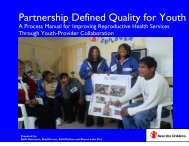

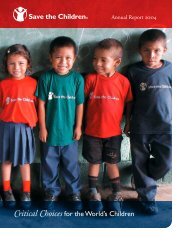
![View full document [PDF 3.39 MB] - PreventionWeb](https://img.yumpu.com/27308954/1/190x245/view-full-document-pdf-339-mb-preventionweb.jpg?quality=85)
